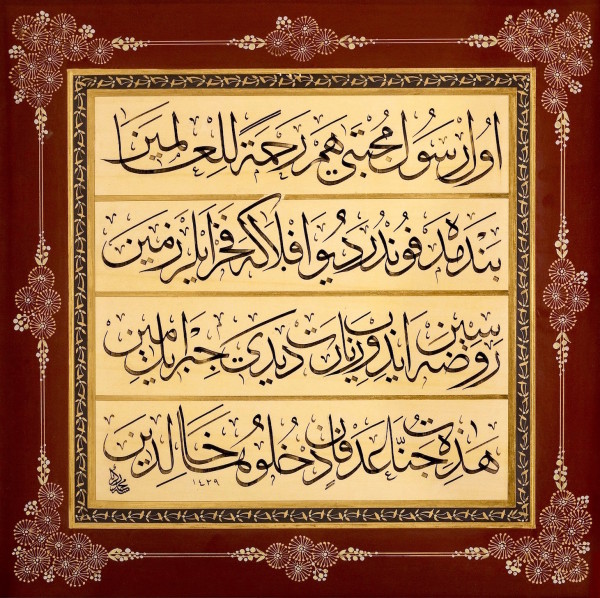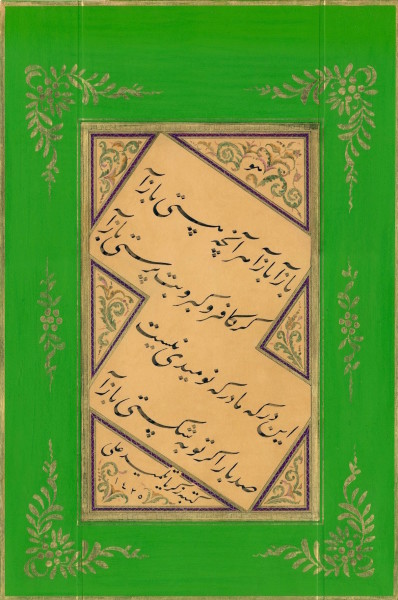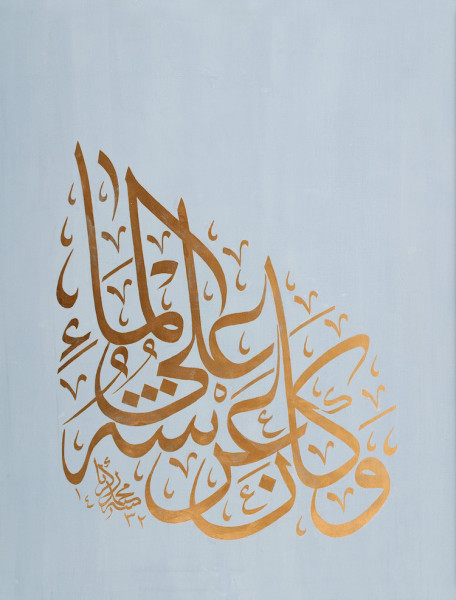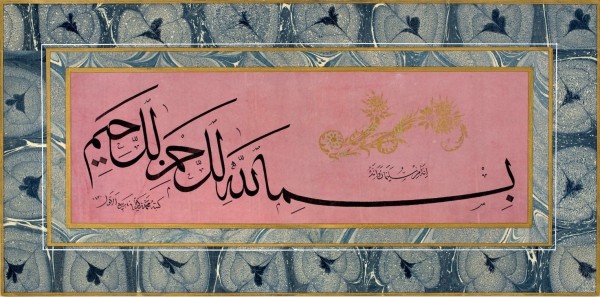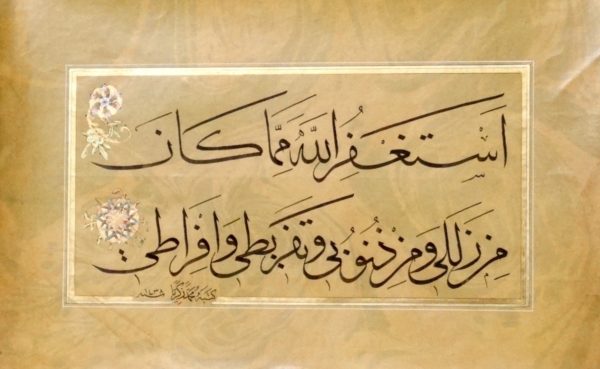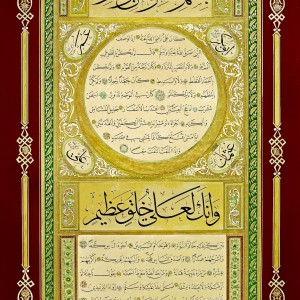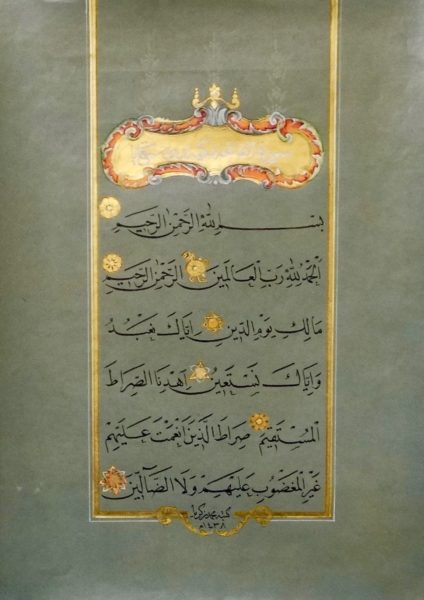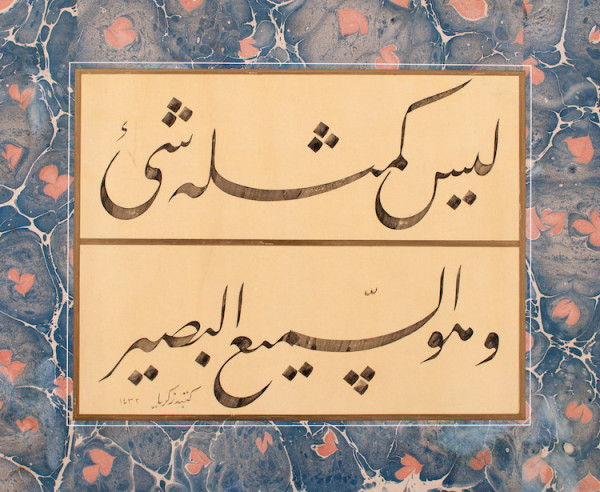This is the second part of the interview that I have conducted with Mohamed Zakariya. He is one of the contemporary masters of calligraphy and just sitting with him and talking, you can learn so much. I wanted to share some of these conversations with you.
Mohamed Zakariya in his studio (2017)
Here Zakariya hoca (teacher) discusses the difference between Islamic and Arabic calligraphy, and its relevance to our time. He also talks about the great importance of silsila, or the chain of transmission for calligraphers, and how 15th century Ottoman master Şeyh Hamdullah combined the precision and beauty of writing in calligraphy. He talks about the architecture of calligraphy and how it should feel, and notes how those two things are different.
Mohamed Zakariya on Islamic vs. Arabic calligraphy
“There is no such thing as [purely] Islamic art anymore in the world. Islamic art existed when there was an Islamic culture that existed among the different countries. We now have national cultures (Iraqi culture, Turkish culture – the culture is colored by nationality). So, you can’t take [all of] that and say it’s all Islamic. It has a characteristic of Islam, of course, but when you look at it, the people who were calligraphers in those days are very different from the ones now. Almost all of calligraphy came from the religious establishment; they were brought up memorizing the Quran and they went to various levels of [Islamic] education. Most of them held official jobs in the Ottoman state and also free-lanced with commissions for their artwork.”
He continued, “I have been in this field for almost 55 years and I know that you can’t just say whether an art is Islamic or Arabic calligraphy. There is no name for it anymore. If you go to a museum, they are going to say it’s Islamic calligraphy, but that doesn't tell you what language it’s written in (could be Arabic, or Persian), nor the professors who taught it and who they were. I believe that, facing the future, the art is not owned by any nation. It is our Muslim gift to the world.”
Genealogy of Ottoman calligraphers (source: Letters in Gold)
“So my preference is find my own way to express [what I do] based on who taught me. For me, [Turkish master] Hasan Çelebi taught me and Hasan hoca was taught by [master] Hamid [Aytac], and the chain continues forming a huge tree, the silsila (in Arabic), or the chain of transmission. There is not just one tree anymore, but there’s tons of ropes or branches in each tree, which tells you who taught each student and the chain continues across many branches. Some day, inshallah (God willing), it will form a forest of trees.”
As we learn from Zakariya hoca, and his student Elinor Aishah Holland, we too find our own connection to the branches of the tree of calligraphy.
Mohamad Zakariya On Precision and Feel
Hoca continued, that this methodology of teaching and calligraphic transmission from teacher to student is molded by the father of Ottoman school of calligraphy, Şeyh Hamdullah. He is the one who laid all the groundwork for how this art is practiced and taught. Şeyh Hamdullah combined precision and beauty in a way that was never done before.
One of hoca’s specialties is the North African writing, the Maghrebi script. He said it is the first script he learned and he is very fond of it, but it’s not precision writing unlike thuluth, or naskh scripts.
Mesk (practice) sheet displaying the proportion in red dots (nuktas) of thuluth and naskh style scripts (Mohamed Zakariya)
When you look at a writing of thuluth script, you will notice invisible lines going in a certain angle that have measurements, like 5 dots or 10 dots. Hoca said, “these relationships of dimensions are only the beginning of writing.” Therefore, when you are first learning how to write in Arabic calligraphy, you are learning the measurements of letters. He said in the beginning it was hard for him to imagine how he would make a letter 5 dots (nuktas) every time. But he said his background as a machinist helped him conceptualize the size the precision of a 5-dotted letter, 6-dot, or 10-dot letter.
“Dots are the architecture of the letters. That’s just your foundation. You have to have the ‘breadth like flow.’ It doesn’t only refer to the flow of ink, but how the pen moves on the paper – it also refers to the feedback [you can feel from the paper]. This is very complicated stuff.”
Calligraphy, to me, is a journey. In the beginning, you learn the rigid rules, but soon it becomes more about motion and feel. You develop a real connection with the letters. You can truly conceptualize this when seeing Zakariya hoca work on letters.
For more information on Mohamed Zakariya's work, please visit his website: http://mohamedzakariya.com/
Gallery of Mohamed Zakariya's work (source: http://mohamedzakariya.com/)
